Demountables in the limelight
Page 113

Page 114

Page 115
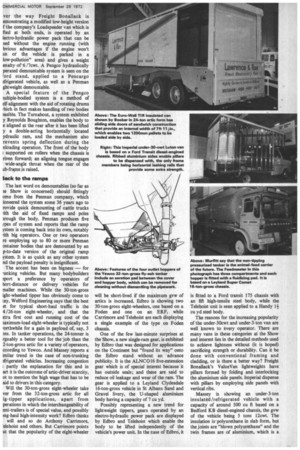
Page 116

Page 119
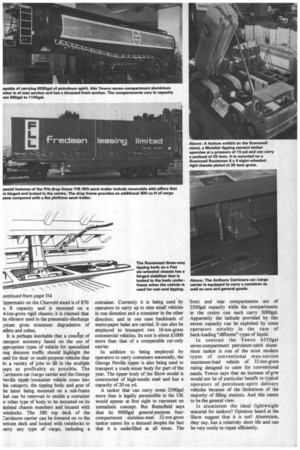
Page 121
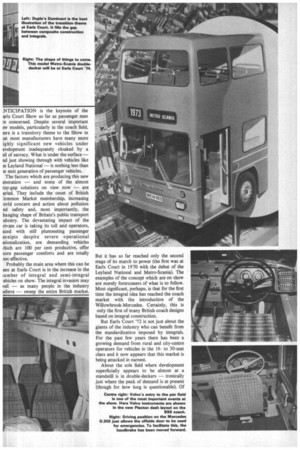
Page 122
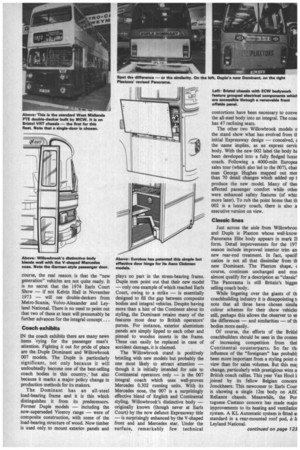
Page 125
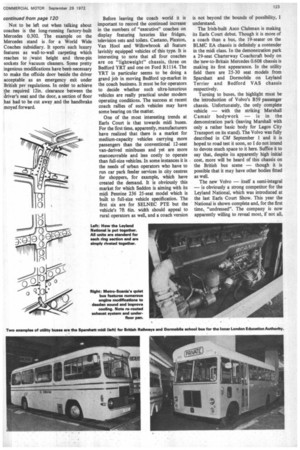
Page 126
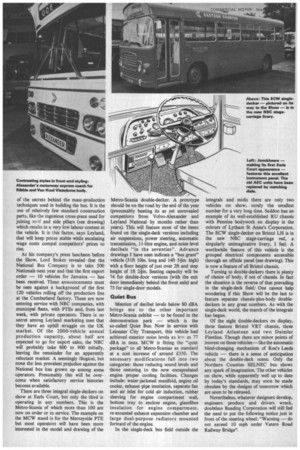
If you've noticed an error in this article please click here to report it so we can fix it.
gut which method will Alin out, asks Paul grockington
[HE QUESTION has been asked over the rears at Earls Court and at Continental ;hows: when will the ideal type of lemountable system be evolved? There are o many demountable systems at the Show his year and so many operators are said to x going for demountables in the UK and m the Continent that the exhibits in total :ould be cited as the most notable evidence )f• the viability of the system so far. But udging by the variety of types the ideal ;ystem (for application to all types of ion-lightweight vehicle) is as far off as ever t was. Maybe there'll never be an ideal ;ysteni. So which is the best? Many visitors o Earls Court will be asking themselves hat question.
Ford is to be congratulated for producing chassis, the 10-ton D series 1010, that is quipped with air suspension specifically
Left: The vehicle on the left is equipped with a Penman built-in full-hydraulic system while the body on the right is raised by a garage jack acting on plungers attached to the body — another Penman system.
designed for demountable body applications, which might well be considered the most interesting and possibly important single item of goods bodywork news of the Show. It has been claimed by a number of bodybuilders that operators are increasingly taking their advice regarding the most suitable chassis for particular types of body, including big tippers, refrigerated vehicles, light vans, tankers, bulkers and specials. Ford has for many years been keenly aware in a practical way of the value to bodybuilders of co-operating fully with them. And the production of a chassis with demountables in mind could be cited as an object lesson in such co-operation. It would be unkind to Ford to say that it was overdue.
The system on the Ford D1010 was evolved by Boalloy and was chosen by Ford following evaluation of a number of systems. A Hands Neway air suspension, developed for this application, is fitted to the rear axle of the chassis. With the body raised by pressurizing the air bellows and the rear legs in the lowered position, the chassi! is driven forward and rollers at the froni of the body sub-frame move up ramps onto runners, the lift being sufficient to provide clearance for the front legs in the lowered position. The weight penalty compared with a similar vehicle with a fixed body is around 7 /8cwt. Boalloy claims that it has a very export potential.
Pengco can be given credit for evolving z demountable system operated by the vehicle's air suspension some 12 month5 ago. And in a live demonstration at the Show, a Commer VC5 chassis with ail suspension applied to the rear axle is to be seen in operation carrying two 9ft bodie: which are unloaded with the aid of the vehicle suspension, the fronts of sub-frame: being equipped with rollers. In this case the weight penalty is around 30cwt.
It is pertinent to point out that the weigh! of the body sub-frame could be reduced b) 3cwt or more if a chassis were available with a controllable air suspension at the front as well as the rear. It would then be possible to raise the chassis at both ends ir one operation with the vehicle chassis it place and to dispense with a heav3 sub-frame and rollers. This might be the ideal. But air suspension all round is as ye of academic interest with little hope o application in the foreseeable future. Or i! it? Ask Ford! The basic system could hi applied to bigger vehicles. Ford has e three-axle version of the Show model or operational trials in Austria.
It is notable that a Freight Bonallacl brewery body is mounted on the sub-framt of the Boalloy system of the For demountable (on the Ford stand) and tha
ver the way Freight Bonallack is emonstrating a modified low-height version f the company's Loadspeeder van which is fted at both ends, is operated by an lectro-hydraulic power pack that can be sed without the engine running (with bvious advantages if the engine won't an or the vehicle is parked in a low-pollution" area) and gives a weight enalty•or6 /7cwt. A Pengco hydraulically perated demountable system is seen on the 'ord stand, applied to a Pencargo 3frigerated vehicle, as well as a Penman ghtweight demountable.
A special feature of the Pengco iultiple-bodied system is a method of elf-alignment with the aid of rotating drums 'Inch in fact makes handling of two bodies :asible. The Turnabout, a system exhibited y Reynolds Boughton, enables the body to e aligned at the rear after it has been lifted y a double-acting horizontally located ydraulic ram, and the mechanism also revents spring deflection during the nloading operation. The front of the body ; supported on rollers when the chassis is riven forward; an aligning tongue engages wide-angle throat when the rear of the ab-frarne is raised.
lack to the ramps
The last word on demountables (so far as le Show is concerned) should fittingly ome from the Penman company, which ioneered the system some 36 years ago to rovide quick demounting of cattle trucks rith the aid of fixed ramps and poles 'trough the body. Penman produces five ,Tpes of system and reports that the ramp ystem is coming back into its own, notably rith big operators. One or two operators re employing up to 80 or more Penman ontainer bodies that are demounted by an p-to-date version of the original ramp ystem. It is as quick as any other system nd the payload penalty is insignificant.
The accent has been on bigness — for .unking vehicles. But many bodybuilders sport a preference by operators of hort-distance or delivery vehicles for maller machines. While the 30-ton-gross ight-wheeled tipper has obviously come to tay, Welford Engineering says that the best et for typical short-haul traffic is the 4 /26-ton eight-wheeler, and that the xtra first cost and running cost of the iaximum-load eight-wheeler is typically not rorthwhile for a gain in payload of, say, 3 ms. In tanker operations, the 24-tonner is rguably a better tool for the job than the 2-ton-gross artic for a variety of operators, ccording to Yewco. And Massey reports a amilar trend in the case of non-trunking 3frigerated vehicles. Increasing congestion
partly the explanation for this and in art it is the outcome of artic-driver scarcity, Otto mention the high wage that has to be aid to drivers in this category.
Will the 30-ton-gross eight-wheeler take ver from the 32-ton-gross artic for all ig-tipper applications, apart from perations in which the interchangeability of 3mi-trailers is of special value, and possibly mg-haul high-intensity work? Edbro thinks will and so do Anthony Carrimore, elehoist and others. But Carrimore points ut that the popularity of the eight-wheeler will be short-lived if the maximum gvw of artics is increased. Edbro is showing two 30-ton-gross eight-wheelers, one based on a Foden and one on an ERF, while Carrimore and Telehoist are each displaying a single example of the type on Foden chassis.
One of the few last-minute surprises at the Show, a new single-ram gear, is exhibited by Edbro that was designed for applications on the Continent but "found its way" onto the Edbro stand without an advance publicity. It is the ALNC016 five-extension gear which is of special interest because it has outside seals; and these are said to reduce oil leakage and wear of the ram. The gear is applied to a Leyland Clydesdale 16-ton-gross vehicle in St Albans Sand and Gravel livery, the U-shaped aluminium body having a capacity of 7 Cu yd.
Possibly representing a new trend for lightweight tippers, gears operated by an electro-hydraulic power pack are displayed by Edbro and Telehoist which enable the body to be lifted independently of the vehicle's power unit. In the case of Edbro, it
is fitted to .a Ford transit 175 chassis with an 8ft high-tensile steel body, while the Telehoist unit is seen applied to a Handy 1+ Cu yd steel body.
The reasons for the increasing popularity of the under-30cwt and under-3-ton van are well known to every operator. There are many vans in these categories at the Show and interest lies in the detailed methods used to achieve lightness without (it is hoped) sacrificing strength or durability. Can it be done with conventional framing and cladding, or is there a better way? Freight Bonallack's ValueVan lightweights have pillars formed by folding and interlocking the aluminium side panels. Imperial dispense with pillars by employing side panels with vertical ribs.
Massey is showing an under-3-ton insulated/refrigerated vehicle with a capacity of around 500 cu ft based on a Bedford KB diesel-engined chassis, the gvw of the vehicle being 5 tons 12cwt. The insulation is polyurethane in slab form, but the joints are "blown polyurethane" and the twin frames are of aluminium, which is a type of construction used for larger vehicles. An Imperial ribbed-aluminium under-30cwt Luton van is based on a Ford Transit 175 diesel-engined chassis/cab and has a capacity of 550 cu ft. Many types of under-30cwt and under-3-ton van are on view.
Makers of refrigerated bodies are hopefully confident that legislation will be brought in that will make the use of an approved type of body obligatory for carrying meat and other types of perishable food including cream buns, as is the case in some European countries, Heatwaves can play havoc with hygiene, which is a problem anyway. Many operators take a chance on it not happening and carry at a cut rate.
Bonallack Refrigerated Vehicles use the rather grandiose term "controlled environment" in describing the overall requirement of top-fussy traders for transporting their goods and instance Marks and Spencer as a very notable example. A Bonallack Coldsaver 40ft aluminium artic with M and S livery provides temperature control t within close limits of Ideg C, a specit feature of the materials used being th application of a baked acrylic finish to th interior as well as the exterior panels, whic is cited as a very big advance in refrigerate vehicle development because of the eas with which the panels can be cleanec Temperature control is provided by twin-tank liquid-nitrogen unit whic Bonallack claims, is particularly suitable fa the type of store-delivery work on which th vehicle will be engaged. It gives a rapi temperature pull-down time and eliminate the noise problem. The polyurethan insulation is in slab form, which Bonallac prefers to foamed insulation because it density is invariably uniform.
The prospect of date marking an shelf-life marking of cooked meats an other perishable foods is cited by Silverdal as an influence that could foster th increased use of insulated/refrigerate vehicles in place of insulated types (whic can retain the heat following a temperatur rise) as temperature control would in th event become a necessary part of the overa production /distribution pattern. Silverdal claims that the continuous glassfibre interia lining of the company's 40ft all-glue insulated van is the best for hygiene becaus it is non-absorbent, is easily cleaned and (c special importance) is resistant to damage.
Promoting hygiene York also looks forward to stricte control of perishable goods in transit an emphasizes the need for features tht promote hygiene. The company's nel Freightmaster 40ft refrigerated van is line with glassfibre sheets having a white gl coat, while Plastibloc duckboards are lai on the floor to provide air circulation, whic are preferred to an aluminium reefer flea Currently Plastibloc is imported; having thickness of lfin. the boards are easil removable to enable pallets to be carrie and their weight is minimal, Thinner board could be used if loading height were critical The non-tipping/pressurized type c animal feed bulk-delivery vehicle has bee said to have one advantage and or advantage only over the tipping type wit rotary seal discharge, namely (in sorn applications) its low loading height. Murfi makes both types and claims that tt pressurized tanker with multiple compar ments has a bigger future. Advantage claimed for the company's Feedmaste three-compartment I6-ton-gross tankt include a reduced number of working pan compared with a tipping vehicle, a quicke turnround, easier servicing and a facility fc carrying different loads in eac compartment. The maierial is discharge from hoppers, each of which is equippe with a fluidizing system.
According to Charrold technicians thei is no evidence of a trend towards pressur tankers which, they point out, need a mm specialized loading system, cannot carr backloads of sacks and so on and are mot likely to give mechanical trouble. The emphasize that the value of versatility likely to increase, not decrease. ippennatic on the Charrold stand is of 870 u ft capacity and is mounted on a 4-ton-gross rigid chassis; it is claimed that he vibrator used in the pneumatic-discharge ystem gives minimum degradation of iellets and cubes.
It is perhaps inevitable that a concept of ran sport economy based on the use of ippropriate types of vehicle for specialized ong distance traffic should highlight the teed for dualor multi-purpose vehicles that to a variety of jobs to fill in the multiple ;aps as profitably as possible. The L'arrimore car /cargo carrier and the George
■ Ieville tipper/container vehicle come into his category, the tipping body and gear of he latter being mounted on a sub-frame hat can be removed to enable a container n. other type of body to be mounted on its ikeletal chassis members and located with wistlocks. The 38ft top deck of the 2.arrimore carrier can be lowered on to the )ottom deck and locked with twistlocks to :.arry any type of cargo, including a
container. Currently it is being used by operators to carry up to nine small vehicles in one direction and a container in the other direction; and in one case backloads of waste-paper bales are carried. It can also be employed to transport two 16-ton-gross commercial vehicles. Its cost is about £1000 more than that of a comparable car-only carrier.
In addition to being employed by operators to carry containers seasonally, the George Neville tipper is also being used to transport a truck-mixer body for part of the year. The tipper body of the Show model is constructed of high-tensile steel and has a capacity of 20 Cu yd.
A tanker that can carry some 2500ga1 more than is legally permissible in the UK would appear at first sight to represent an unrealistic concept. But Butterfield says that its 9000gal general-purpose fourcompartment stainless-steel 32-ton-gross tanker caters for a demand despite the fact that it is underfilled at all times. The front and rear compartments are of 2500gal capacity while the compartments in the centre can each carry 2000gal. Apparently the latitude provided by this excess capacity can be exploited by some operators notably in the case of back-loading "different" types of liquid.
In contrast the Yewco 6550ga1 seven-compartment petroleum-spirit aluminium tanker is one of the most modern types of conventional max-section maximum-load vehicle of 32-ton-gross rating designed to cater for conventional needs. Yewco says that an increase of gvw would not be of particular benefit to typical operators of petroleum-spirit delivery vehicles because of the limitations of the majority of filling stations. And this seems to be the general view.
Is aluminium the ideal lightweight material for tankers? Opinions heard at the Show suggest that it is not! Aluminium, they say, has a relatively short life and can be very costly to repair efficiently. .NTICIPATION is the keynote of the ads Court Show so far as passenger men re concerned. Despite several important ew models, particularly in the coach field, 'ere is a transitory theme to the Show in tat most manufacturers have many more ighly significant new vehicles under evelopment inadequately cloaked by a eil of secrecy. What is under the surface — ad just showing through with vehicles like le Leyland National — is nothing less than le next generation of passenger vehicles. The factors which are producing this new eneration — and some of the almost top-gap solutions on view now — are aried. They include the onset of British :ommon Market membership, increasing 'odd concern and action about pollution nd safety and, most importantly, the hanging shape of Britain's public transport idustry. The devastating impact of the rivate car is taking its toll and operators, iced with still plummeting passenger eceipts despite severe operational ationalization, are demanding vehicles thich are 100 per cent productive, offer [lore passenger comforts and are totally ost-effective.
Probably the main area where this can be een at Earls Court is in the increase in the lumber of integral and semi-integral 'dicks on show. The integral invasion may veil — as many people in the industry lelieve — sweep the entire British market. But it-has so far reached only the second stage of its march to power (the first was at Earls Court in 1970 with the debut of the Leyland National and Metro-Scania). The • examples of the concept which are on show are merely forerunners of what is to follow. Most significant, perhaps, is that for the first time the integral idea has reached the coach market with the introduction of the Willowbrook-Mercedes. Certainly, this is only the first of many British coach designs based on integral construction.
But Earls Court '72 is not just about the giants of the industry who can benefit from the standardization imposed by integrals. For the past few years there has been a growing demand from rural and city-centre operators for vehicles in the 16to 30-seat class and it now appears that this market is being attacked in earnest.
About the sole field where development superficially appears to be almost at a standstill is in double-deckers — ironically just where the peak of demand is at present (though for how long is questionable). Of course, the real reason is that the "new generation" vehicles are not quite ready. It is no secret that the 1974 Earls Court Show — if not Kelvin Hall in November 1973 — will see double-deckers from Metro-Scania, Volvo-Alexander and Leyland National. There is no need to point out that two of these at least will presumably be further advances for the integral concept ...
Coach exhibits IN the coach exhibits there are many news items -vying for the passenger man's attention. Fighting it out for pride of place are the Duple Dominant and Willowbrook 007 models. The Duple is particularly significant, not only because it will undoubtedly become one of the best-selling coach bodies in this country, ' but also because it marks a major policy change in production methods for its makers.
The Dominant has an all-steel load-bearing frame and it is this which distinguishes it from its predecessors. Former Duple models — including the now-superseded Viceroy range — were of composite construction, with some of the load-bearing structure of wood. Now timber is used only to mount exterior panels and plays no part in the stress-bearing frame. Duple men point out that their new model — only one example of which reached Earls Court, owing to a strike — is essentially designed to fill the gap between composite bodies and integral vehicles. Despite having more than a hint of the Continent about its styling, the Dominant retains many of the features most dear to British operators' purses. For instance, exterior aluminium panels are simply lipped to each other and pinned to wooden inserts in the frame. These can easily be replaced in case of accident damage, it is claimed.
The Willowbrook stand is positively bristling with new models but probably the one most likely to attract attention — though it is initially intended for sale to Continental operators only — is the 007 integral coach which uses well-proven Mercedes 0.302 running units. With its Mercedes nose, the 007 is a surprisingly effective blend of English and Continental styling. Willowbrook's distinctive body — originally known (though never at Earls Court) by the now defunct Expressway title — is surprisingly enhanced by the V-shaped front end and Mercedes star. Under the surface, remarkably few technical contortions have been necessary to conve the all-steel body into an integral. The coac has 47 reclining seats.
The other two Willowbrook models a the stand show what has evolved from tt initial Expressway design — conceived, 'z the name implies, as an express servic body. With the new 002 label the body lit been developed into a fully fledged luxur coach. Following a 4000-mile Europea sales tour (which also led to the 007), chai: man George Hughes mapped out mot than 70 detail changes which added up t produce the new model. Many of thes affected passenger comfort while other were enhanced safety features (of whic more later). To rub the point home that th 002 is a luxury coach, there is also a executive version on view.
Classic lines Just across the aisle from Willowbroo and Duple is Plaxton whose well-know .Panorama Elite body appears in mark II form. Detail improvements for the 197 season include improved interior trim an new rear-end treatment. In fact, specif cation is not all that dissimilar from th new Dominant. The Plax ton shape, course, continues unchanged and 111u5. almost qualify for a description as "classic' The Panorama is still Britain's bigge5 selling coach body.
While lingering over the giants of th coachbuilding industry it is disappointing tl note that all three have chosen simila colour schemes for their show vehicle5 still, perhaps this allows the observer to se the differences — and similarities — of th bodies more easily.
Of course, the efforts of the Britisl coachbuilders should be seen in the contex of increasing competition from thei Continental counterparts. So far th influence of the "foreigners" has probabl been more important from a styling point o view than for sales volumes. But this ma: change, particularly with prestigious wins a British coach rallies. This year Van Hool i; joined by its fellow Belgian concern Jonckheere. This newcomer to Earls Cour is showing a single 12m body on AEC Reliance chassis. Meanwhile, the Por tuguese Caetano concern has made majo] improvements to its heating and ventilatior system. A KL Automatic system is fitted a; standard in a rear-mounted roof pod, a it Leyland National. Not to be left out when talking about coaches is the long-running factory-built Mercedes 0.302. The example on the Mercedes stand is for a World Wide Coaches subsidiary. It sports such luxury features as wall-to-wall carpeting which reaches to waist height and three-pin sockets for vacuum cleaners. Some pretty ingenious modifications have been necessary to make the offside door beside the driver acceptable as an emergency exit under British psv regulations. In order to achieve the required 12in. clearance between the driver's seat and the door, a section of floor has had to be cut away and the handbrake moyed forward. Before leaving the coach world it is important to record the continued increase in the numbers of "executive" coaches on display featuring luxuries like fridges, television sets and toilets. Caetano, Plaxton, Van Hool and Willowbrook all feature lavishly equipped vehicles of this type. It is interesting to note that all four coaches are on "lightweight" chassis, three on Bedford YRT and one on Ford R1114. The YRT in particular seems to be doing a grand job in moving Bedford up-market in the coach business. It must be for operators to decide whether such ultra-luxurious vehicles are really practical under modern operating conditions. The success at recent coach rallies of such vehicles may have some bearing on the matter.
One of the most interesting trends at Earls Court is that towards midi buses. For the first time, apparently, manufacturers have realized that there is a market for medium-capacity vehicles carrying more passengers than the conventional 12-seat van-derived minibuses and yet are more manoeuvrable and less costly to operate than full-size vehicles. In some instances it is the needs of urban operators who have to run car park feeder services in city centres for shoppers, for example, which have created the demand. It is obviously this market for which Seddon is aiming with its midi Pennine 236 25-seat model which is built to full-size vehicle specification. The first six are for SELNEC PTE but the vehicle's 7ft 6in. width should appeal to rural operators as well, and a coach version is not beyond the bounds of possibility, I understand.
The Irish-built Asco Clubman is making its Earls Court debut. Though it is more of a coach than a bus, the 19-seater on the BLMC EA chassis is definitely a contender in the midi class. In the demonstration park a 29-seat Charterway Coachcraft body on the new-to-Britain Mercedes 0.608 chassis is making its first appearance. In the utility field there are 25-30 seat models from Sparshatt and Dormobile on Leyland Terrier and Bedford VAS chassis respectively.
Turning to buses, the highlight must be the introduction of Volvo's B59 passenger chassis. Unfortunately, the only complete vehicle — with the striking Marshall Camair bodywork — is in the demonstration park (leaving Marshall with only a rather basic body for Lagos City Transport on its stand). The Volvo was fully described in CM September 1 and it is hoped to road test it soon, so I do not intend to devote much space to it here. Suffice it to say that, despite its apparently high initial cost, more will be heard of this chassis on the British bus scene — though it is possible that it may have other bodies fitted as well.
The new Volvo — itself a semi-integral — is obviously a strong competitor for the Leyland National, which was introduced at the last Earls Court Show. This year the National is shown complete and, for the first time, "undressed". The company is now apparently willing to reveal most, if not all. of the secrets behind the mass-production techniques used in building the bus. It is the use of relatively few standard construction parts, like the ingenious cross-piece used for joining ronf and side pillars (see drawing) which results in a very low labour content in the vehicle. It is this factor, says Leyland, that will keep prices stable while escalating wage costs compel competitors' prices to rise.
At his company's press luncheon before the Show, Lord Stokes revealed that the National Bus Company is to take 500 Nationals next year and that the first export order — 10 vehicles for Jamaica — has been received. These announcements must be seen against a background of the first 120 vehicles rolling off the production line at the Cumberland factory. These are now entering service with NBC companies, with municipal fleets, with PTEs and, from last week, with private operators. There is no secret among Leyland marketing men that they have an uphill struggle on the UK market. Of the 2000-vehicle annual production capacity, about half are expected to go for export sales, the NBC will probably take 800 to 900 initially, leaving the remainder for an apparently reluctant market. A seemingly illogical, but none the less prevalent prejudice against the National bus has grown up among some operators. Presumably this will be overcome when satisfactory service histories become available.
There are three integral single-deckers on show at Earls Court, but only the third is operating in any numbers. This is the Metro-Scania of which more than 100 are now on order or in service. The example on the MCW stand is for the Merseyside PTE but most operators will have been more interested in the model and drawing of the Metro-Scania double-decker. A prototype should be on the road by the end of the year (presumably beating its as yet unrevealed competitors from Volvo-Alexander and Leyland National by months rather than years). This will feature most of the items found on the single-deck versions including air suspensions, power steering, automatic transmission, 11-litre engine, and noise level decibels "in the seventies". Advance drawings I have seen indicate a "bus grant" vehicle (31ft 10in, long and 14ft 5+in. high) with a floor height of just over 2ft and step height of lft 2fin. Seating capacity will be 74 for double-door versions (with the exit door immediately behind the front axle) and 75 for single-door models.
Quiet Bus
Mention of decibel levels below 80 dBA brings me to the other important Metro-Scania exhibit — to be found in the demonstration park — which is the so-called Quiet Bus. Now in service with Leicester City Transport, this vehicle had achieved exterior noise levels as as 77 dBA in tests. MCW is fitting the "quiet package" to all Metro-Scanias as standard at a cost increase of around £350. The necessary modifications fall into two categories: those reducing sound levels and those restoring to the now encapsulated engine proper cooling facilities. Changes include: water-jacketed manifold, engine oil cooler, exhaust pipe insulation, separate fan and air inlet for cold air induction, rubber sleeving for engine compartment wall, bottom tray to enclose engine, glassfibre insulation for engine compartment, re-mounted exhaust expansion chamber and large dual-purpose radiators mounted forward of the engine.
In the single-deck bus field outside the integrals and midis there are only two vehicles on show, surely the smallest number for a very long time. Seddon has an example of its well-established RU chassis with Pennine bodywork on display in the colours of Lytham St Anne's Corporation. The ECW single-decker on Bristol LH is in the new NBC stage-carriage red, a singularly unimaginative livery, I feel. A worthwhile feature of this vehicle is the grouped electrical components accessible through an offside panel (see drawing). This is now a feature of all Bristol chassis.
Turning to double-deckers there is plenty of choice of body, if not of chassis. In fact the situation is the reverse of that prevailing in the single-deck field: One cannot help wondering if this Show will be the last to feature separate chassis-plus-body doubledeckers in any great numbers. As with the single-deck world, the march of the integrals has begun.
Of the eight double-deckers on display, three feature Bristol VRT chassis, three Leyland Atlantean and two Daimler Fleetline. Though there are minor points of interest on these vehicles—like the automatic blind-changing mechanism of Roe's Leeds vehicle — there is a sense of anticipation _about the double-deck scene. Only the Northern Counties SELNEC bus shows any spark of imagination. The other vehicles on show, while apparently well up to date by today's standards, may soon be made obsolete by the designs of tomorrow which are soon to be released.
Nevertheless, whatever designers develop, engineers produce and drivers wreck, doubtless Reading Corporation will still feel the need to put the following notice just in front of the steering wheel: "Warning — do not exceed 10 mph under Vatern Road Railway Bridge".








































































































































































































































